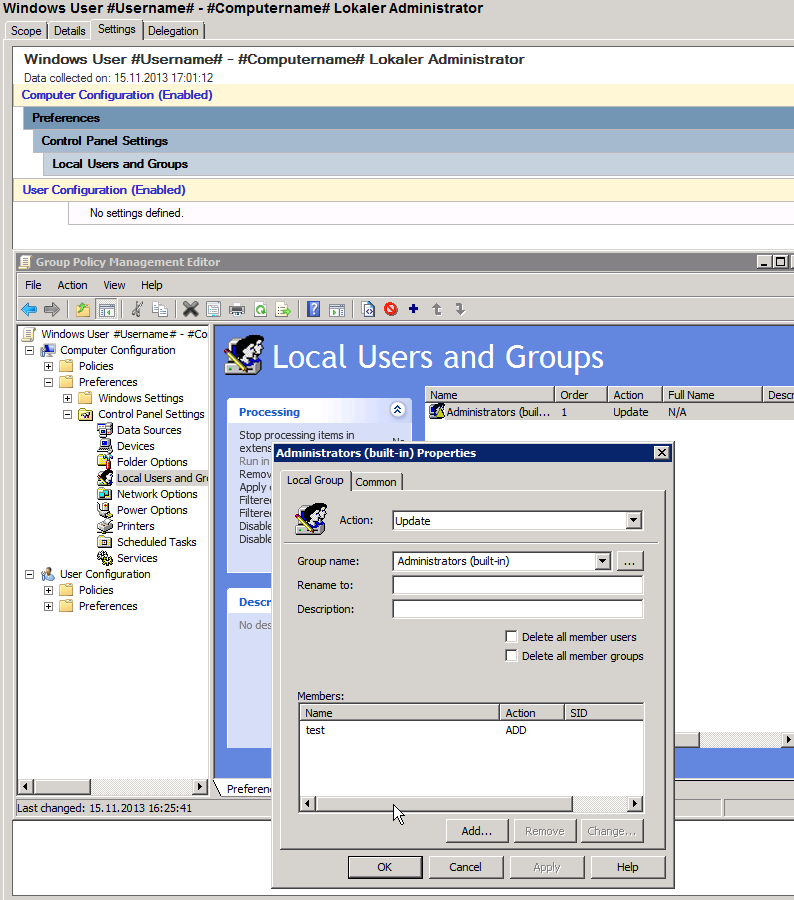
4 min read
Assign Temporary Administrator Rights for ActiveDirectory Users via SharePoint list
In my company the user only have user rights on their computers. As you should know you’ll face many problems with this restriction.
Many users want to install third party software on their computers or add a printer at home. To reduce argues and make the user happy, I’ll assign administrator rights for a temporary time.
Based on a predefined GPO and based on a list showing which user has administrator rights in a specified time period, my PowerShell script creates new temporary GPO to assign local administrator rights.
After the specified time period the scripts deletes the temporary GPO in order to remove the local admin rights.
Here is the template of the predefined GPO:
User “test” is placeholder for the real user.
The list containing the users is stored on SharePoint site:
The scripts reads from the SharePoint list with predefined credentials and remote configuration file wich is part of my PowerShell Profile project (check out the requirements on the bottom).
Watch out to store the computer object in a OU instead of an container, it’s not possible to assign GPOs to an AD container!
<#
$Metadata = @{
Title = "Assign Temporary Administrator Rights"
Filename = "Assign-TemporaryAdministratorRights.ps1"
Description = ""
Tags = "powershell, script, activedirectory, assign, temporary, administrator, rights, computer"
Project = ""
Author = "Janik von Rotz"
AuthorContact = "https://janikvonrotz.ch"
CreateDate = "2013-11-15"
LastEditDate = "2013-11-18"
Url = ""
Version = "1.0.0"
License = @'
This work is licensed under the Creative Commons Attribution-ShareAlike 3.0 Switzerland License.
To view a copy of this license, visit https://creativecommons.org/licenses/by-sa/3.0/ch/ or
send a letter to Creative Commons, 444 Castro Street, Suite 900, Mountain View, California, 94041, USA.
'@
}
#>
try{
#--------------------------------------------------#
# modules
#--------------------------------------------------#
Import-Module ActiveDirectory
Import-Module GroupPolicy
#--------------------------------------------------#
# settings
#--------------------------------------------------#
# var #Username# replaces username, var #Computername# replaces computername
$GPOTemplate = "Windows User #Username# - #Computername# Lokaler Administrator"
$TempFolder = "C:export"
$SPWebUrl = (Get-SPUrl "https://sharepoint.vbl.ch/finanzen/it/Abteilungssite/SitePages/Homepage.aspx").Url
$SPListName = "Temporäre Adminrechte"
$RemoteConnectionKey = "sp1"
#--------------------------------------------------#
# main
#--------------------------------------------------#
$Computer = Get-RemoteConnection -Name $RemoteConnectionKey
$Credential = Import-PSCredential -Path (Get-ChildItem $PSconfigs.Path -Filter "SharePoint.credential.config.xml" -Recurse).FullName
$Session = New-PSSession -ComputerName $Computer.Name -Credential $Credential -ConfigurationName microsoft.powershell
$Computer.SnapIns | %{ Invoke-Command -Session $Session -ScriptBlock {param ($Name) Add-PSSnapin -Name $Name} -ArgumentList $_}
[ScriptBlock]$ScriptBlock = [scriptblock]::Create(@"
Get-SPWeb '$SPWebUrl' | %{
`$_.Lists['$SPListName'].GetItems() | %{
`$(New-Object PSObject -Property @{
Mail = `$_["Title"].toString()
Computer = `$_["Computer"].toString()
From = `$_["From"].toString()
To = `$_["To"].toString()
})
}
}
"@)
$Config = Invoke-Command -Session $Session -ScriptBlock $ScriptBlock
Remove-PSSession $Session
<#
$Config = @(
$(New-Object PSObject -Property @{
Mail = "name.surname@domain.ch"
Computer = "tpbmar1"
From = "18.11.2013"
To = "25.11.2013"
}),
$(New-Object PSObject -Property @{
Mail = "name.surname@vbl.ch"
Computer = "tpfit9"
From = "15.11.2013"
To = "21.11.2013"
}),
)
#>
$Config | %{
# get settings
$ADComputer = Get-ADComputer $_.Computer
$ADUser = Get-ADUser -Filter "mail -eq '$($_.Mail)'" | select -first 1
$GPOName = ($GPOTemplate -replace "#Username#", $ADUser.Name -replace "#Computername#", $ADComputer.Name)
$SourceGPO = Get-GPO $GPOTemplate
$TargetOU = $ADComputer.DistinguishedName -replace "CN=$($ADComputer.Name),",""
$FromDate = Get-Date $_.From
$ToDate = Get-Date $_.To
$Date = $(Get-Date)
# create temp folder
if(-not (Test-Path $TempFolder)){New-Item -Path $TempFolder -ItemType Directory}
# get gpo
$GPO = Get-GPO -Name $GPOName -ErrorAction SilentlyContinue
# create if not exist
if(-not $GPO -and $Date -gt $FromDate -and $Date -lt $ToDate){
# create new gpo
$GPO = New-GPO -Name $GPOName
$GPO | New-GPLink -Target $TargetOU
$GPO | Set-GPPermissions -Replace -PermissionLevel None -TargetName "Authentifizierte Benutzer" -TargetType Group
$GPO | Set-GPPermissions -PermissionLevel GpoApply -TargetName $ADComputer.Name -TargetType Computer
# backup template gpo
$GPOBackup = $SourceGPO | Backup-GPO -Path $TempFolder
$PathToXML = Join-Path $TempFolder ("{" + $GPOBackup.Id + "}DomainSysvolGPOMachinePreferencesGroupsGroups.xml")
$PathToFolder = Join-Path $TempFolder ("{" + $GPOBackup.Id + "}")
[xml]$GroupXML = Get-Content $PathToXML
# update template gpo settings
$GroupXML.Groups.Group.Properties.Members.Member.name = $(Get-ADDomain).NetBIOSName + "" +$ADUser.SamAccountName
$GroupXML.Groups.Group.Properties.Members.Member.sid = "$($ADUser.SID)"
$GroupXML.Save($PathToXML)
# import to new gpo
Import-GPO -BackupId $GPOBackup.Id -TargetGuid $GPO.Id -path $TempFolder
# clean up tempfolder
Remove-Item $PathToFolder -Force -confirm:$false -Recurse
Write-PPEventLog -Message "Added temporary administrator rights for: $($_.Mail) on computer: $($_.Computer)" -Source "Assign Temporary Administrator Rights" -WriteMessage
# delete gpo
}elseif($GPO -and $Date -gt $ToDate ){
$GPO | Remove-GPO
Write-PPEventLog -Message "Removed temporary administrator rights for: $($_.Mail) on computer: $($_.Computer)" -Source "Assign Temporary Administrator Rights" -WriteMessage
}
}
}catch{
Write-PPErrorEventLog -Source "Assign Temporary Administrator Rights"
}
Run this script as a hourly or daily scheduled task.
Latest version of this script: https://gist.github.com/7487228
Requirements to run this script:
Categories: scripting , SharePointTags: activedirectory , administrator , sharepoint , temporary
Edit this page
Show statistic for this page

